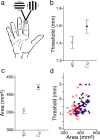Diminutive digits discern delicate details: fingertip size and the sex difference in tactile spatial acuity
- PMID: 20016091
- PMCID: PMC3849661
- DOI: 10.1523/JNEUROSCI.3684-09.2009
Diminutive digits discern delicate details: fingertip size and the sex difference in tactile spatial acuity
Abstract
We have observed that passive tactile spatial acuity, the ability to resolve the spatial structure of surfaces pressed upon the skin, differs subtly but consistently between the sexes, with women able to perceive finer surface detail than men. Eschewing complex central explanations, we hypothesized that this sex difference in somatosensory perception might result from simple physical differences between the fingers of women and men. To investigate, we tested 50 women and 50 men on a tactile grating orientation task and measured the surface area of the participants' index fingertips. In subsets of participants, we additionally measured finger skin compliance and optically imaged the fingerprint microstructure to count sweat pores. We show here that tactile perception improves with decreasing finger size, and that this correlation fully explains the better perception of women, who on average have smaller fingers than men. Indeed, when sex and finger size are both considered in statistical analyses, only finger size predicts tactile acuity. Thus, a man and a woman with fingers of equal size will, on average, enjoy equal tactile acuity. We further show that sweat pores, and presumably the Merkel receptors beneath them, are packed more densely in smaller fingers.
Figures




Similar articles
-
A physical constraint on perceptual learning: tactile spatial acuity improves with training to a limit set by finger size.J Neurosci. 2013 May 29;33(22):9345-52. doi: 10.1523/JNEUROSCI.0514-13.2013. J Neurosci. 2013. PMID: 23719803 Free PMC article.
-
Tactile spatial acuity in childhood: effects of age and fingertip size.PLoS One. 2013 Dec 19;8(12):e84650. doi: 10.1371/journal.pone.0084650. eCollection 2013. PLoS One. 2013. PMID: 24454612 Free PMC article.
-
Tactile spatial acuity enhancement in blindness: evidence for experience-dependent mechanisms.J Neurosci. 2011 May 11;31(19):7028-37. doi: 10.1523/JNEUROSCI.6461-10.2011. J Neurosci. 2011. PMID: 21562264 Free PMC article.
-
Postural stabilization from fingertip contact II. Relationships between age, tactile sensibility and magnitude of contact forces.Exp Brain Res. 2005 Jul;164(2):155-64. doi: 10.1007/s00221-005-2238-5. Epub 2005 Mar 8. Exp Brain Res. 2005. PMID: 15754171
-
Human Touch Receptors Are Sensitive to Spatial Details on the Scale of Single Fingerprint Ridges.J Neurosci. 2021 Apr 21;41(16):3622-3634. doi: 10.1523/JNEUROSCI.1716-20.2021. Epub 2021 Mar 15. J Neurosci. 2021. PMID: 33722975 Free PMC article.
Cited by
-
Analysis of haptic information in the cerebral cortex.J Neurophysiol. 2016 Oct 1;116(4):1795-1806. doi: 10.1152/jn.00546.2015. Epub 2016 Jul 20. J Neurophysiol. 2016. PMID: 27440247 Free PMC article. Review.
-
I tap myself, and you tap me: bimanual predictive and reactive grip force control as a function of age.Exp Brain Res. 2024 Nov;242(11):2613-2622. doi: 10.1007/s00221-024-06925-5. Epub 2024 Sep 25. Exp Brain Res. 2024. PMID: 39320436
-
A genetic basis for mechanosensory traits in humans.PLoS Biol. 2012;10(5):e1001318. doi: 10.1371/journal.pbio.1001318. Epub 2012 May 1. PLoS Biol. 2012. PMID: 22563300 Free PMC article.
-
Two-point discrimination values vary depending on test site, sex and test modality in the orofacial region: a preliminary study.J Appl Oral Sci. 2017 Jul-Aug;25(4):427-435. doi: 10.1590/1678-7757-2016-0462. J Appl Oral Sci. 2017. PMID: 28877282 Free PMC article.
-
Emotion Measurements Through the Touch of Materials Surfaces.Front Hum Neurosci. 2020 Jan 17;13:455. doi: 10.3389/fnhum.2019.00455. eCollection 2019. Front Hum Neurosci. 2020. PMID: 32009917 Free PMC article.
References
-
- Bleyenheuft Y, Cols C, Arnould C, Thonnard JL. Age-related changes in tactile spatial resolution from 6 to 16 years old. Somatosens Mot Res. 2006;23:83–87. - PubMed
-
- Bolton CF, Winkelmann RK, Dyck PJ. A quantitative study of Meissner's corpuscles in man. Neurology. 1966;16:1–9. - PubMed
-
- Boulais N, Misery L. Merkel cells. J Am Acad Dermatol. 2007;57:147–165. - PubMed
-
- Craig JC, Johnson KO. The two-point threshold: not a measure of tactile spatial resolution. Curr Dir Psychol Sci. 2000;9:29–32.
Publication types
MeSH terms
LinkOut - more resources
Full Text Sources
